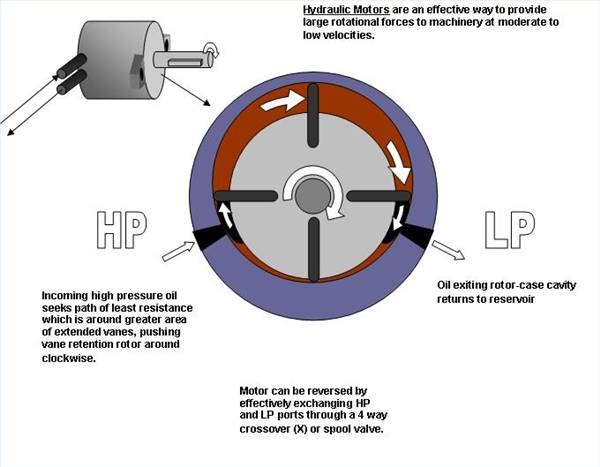
Hydraulic motors provide continuous rotational force and movement via their keyed output shaft to power industrial machinery, agricultural implements such as tractors and harvesters, construction equipment, and various types of special purpose vehicles. Hydraulic power systems, as opposed to shafts, gears, chains, electric motors and wires is much more flexible and cost effective in applications requiring the reliable transmission of high forces and torque at moderate to slow speeds. This is due to the relative ease of conveying a moving fluid under pressure as well as extracting great forces from simple component subsystems.
The strategic advantage of hydraulics is that hydraulic systems use an incompressible lubricating medium to transmit the power to an assortment of both linear and rotational positive displacement motors that empower the total functionality of the machine. An example is an earth excavator used in construction.
Hydraulic motors consist of a rugged motor casing with an internal power rotor module. Each motor has two connection ports -- one for entry and one for return of the hydraulic fluid in the hydraulic circuit. Most motors can be reversed -- switched from clockwise to counterclockwise rotation by reversing the ports with a reversing valve in which case a middle position stops the motor.
Incoming pressurized fluid enters a sealed chamber that represents the engagement of an externally toothed gear inside the cavity of an internally toothed gear with a tight mesh on only one side. However, these teeth are shaped such that some part of their other respective teeth are in contact to form small chambers whose volume is continually changing as they turn together. Since pushing against the teeth forming the walls of these chambers represents the path of least resistance compared to the tightly meshed teeth, the fluid forces its way around the outside of the engagement like a person pushing strongly around a revolving door, and the inside gear forces the output shaft to turn with great force.
Even with variations, all hydraulic motors are positive displacement - they are sealed tightly enough that there is no slipping, and a fixed volume of fluid moving through the motor will produce exactly one revolution of the output shaft. This allows matching small displacement pumps with large displacement hydraulic motors to produce enormous force magnification with proportionately lower velocity -- exactly the goal of most machines using hydraulic motors.
Hydraulic motors are used extensively in construction machinery including graders, dozers, shovels, as well as in every sort of farm implement. In factories, they drive machines, lifts, cranes, and conveyors. Domestically, many riding mowers use hydrostatic transmissions to drive the wheels.
Hydraulic motors enable industrialists to reliably drive many devices - each with their own unique torque and speed requirements from one easy to configure power source that continuously lubricates the entire system while it works.